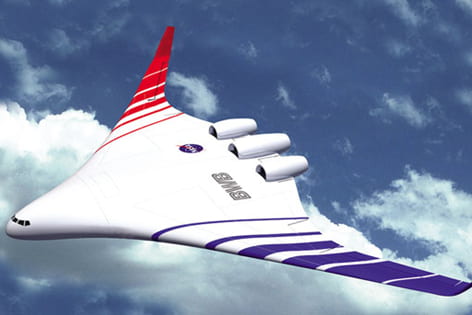Futuristic air travel
Sharp increases in the price of jet fuel and growing concerns about sustainability have spurred demand for greener, more efficient aircraft, and UCI researchers could help shape the future of commercial aeronautics.

Sharp increases in the price of jet fuel and growing concerns about sustainability have spurred demand for greener, more efficient aircraft, and UCI researchers could help shape the future of commercial aeronautics.
“There has been tremendous progress in modern aviation technology,” said Dimitri Papamoschou, mechanical and aerospace engineering professor and associate dean for academic affairs at UC Irvine’s Henry Samueli School of Engineering.
Papamoschou recently shared some thoughts on a handful of trends that will help shape the future of commercial aeronautics.
Innovative, efficient design
Scientists increased efficiency – and reduced excess jet noise – by designing progressively larger turbine engines, which move air more efficiently than smaller ones, resulting in lower levels of noise.
But engines can grow only so big, so researchers have begun evaluating new approaches like the Blended Wing Body aircraft. Co-developed by Robert Liebeck, UCI adjunct professor and program manager for Boeing’s advanced R&D unit, this design is a significant step toward structural, aerodynamic and operational efficiency.
Its engine location also makes it naturally quieter than today’s airplanes.
Papamoschou said the revolutionary design may first be deployed in cargo or military aircraft, but eventually could be used in commercial passenger travel.
Quieter engines will create new possibilities
A number of airports – including Orange County’s John Wayne Airport – restrict operating hours to limit noise over surrounding communities. Quieter aircraft could allow airports to operate continuously, benefiting airlines that otherwise battle the logistic and economic disadvantages of restricted night flight.
If future aircraft could cut noise pollution enough so airports could remain in continuous operation, it would allow airlines to expand late-night service to meet demand and better avoid airport congestion. The advances would help airlines be more profitable, better serve customers and mitigate airport congestion.
“You could operate 24 hours a day without being noticed by the neighbors,” said Papamoschou, who invented a turbofan noise suppression system.
Point-to-point mass transit
Why hassle with the freeway during rush hour when you could fly to your meeting instead?
Here’s how: Compact, 20- to 30-passenger planes would enable commutes between heliports, including helicopter pads on the roofs of office buildings. The infrastructure needed to support this type of transportation is much smaller than for building additional railways or freeways, so the cost of “aerial commuting” could become competitive to the train or bus.
“This could be a very viable alternative to ground transportation,” Papamoschou said.
Key to this concept is the development of the vertical take-off and landing technology that is reliable and quiet, and requires little maintenance. It would enable aircraft to nimbly jump from place to place and skip long airport runways altogether. Also important is development of an advanced traffic control system with enough open “lanes” to safely accommodate aircraft flight patterns.
Supersonic travel
Concorde supersonic passenger jets are retired, but commercial supersonic air travel could revive if scientists can solve efficiency and noise concerns. One of the SST’s limitations was it could travel only above water because it created environmentally unacceptable sonic booms over land.
“It requires ingenuity,” Papamoschou said of overcoming engineering challenges to developing supersonic passenger jets. “But, if supersonic travel can prove itself on a larger scale both environmentally and economically, there is a chance it could revolutionize air travel.”
